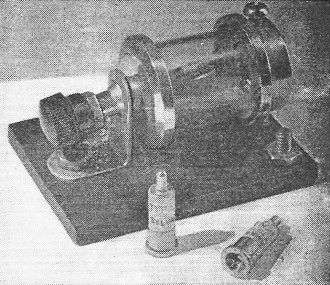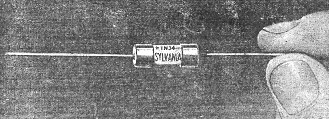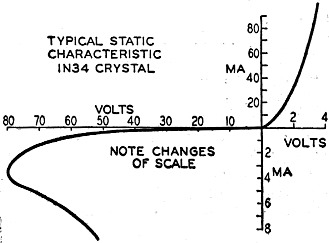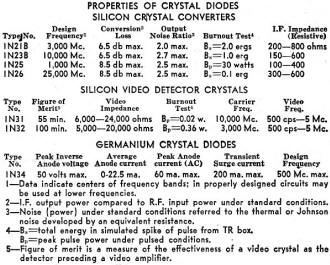H.F. Crystal Diodes
|
|
Crystal diodes have been used as detectors in radio circuits since the 1910s. Originally, the rectification process was effected via a point contact "whisker" (aka "cats whisker") pressed against the crystal's face. It was not mechanically rugged (vibration could cause erratic operation), was sensitive to heat and humidity (if not contained in a hermetic case), and operated at fairly low frequencies. Vacuum tube diodes provided some improvement, but were still limited to operation in the lower hundreds of MHz. Once germanium and silicon crystals became available, operational frequencies climbed into the upper MHz to lower GHz realm, even though, as shown in this 1946 Radio-Craft article, the diodes were of the point contact type. PN junctions at those frequencies were still a few years off. Their smaller size and construction largely mitigated the environmental issues of the early types. The 1950s- vintage S-band radar (and maybe X-band, but I don't recall for certain) I worked on in the USAF used the kind of point contact crystal diode shown here. H.F. Crystal Diodes
Fig. 1 - Modern crystal diode, cross section. The limitations of conventional and even of special types of vacuum-tube diodes make them unusable at the high frequencies used in the most recent radar equipment. It was therefore necessary to develop a new kind of detector for use in the signal frequency sections of u.h.f. and s.h.f. receivers. The answer was found in the crystal diode. Just a few years ago the crystal detector belonged to the archaeology of radio communications. With the discovery of the remarkable properties of hollow wave guides it was resurrected for use in measuring instruments. As development progressed from the u.h.f. into the s.h.f. ranges, the crystal was pressed into service as a circuit element. Considerable research and development work was necessary, however, before these units became entirely satisfactory. Photo A shows a typical crystal detector of the first World War period (1919), together with a modern Sylvania 1N21B crystal diode. Crystal Diode Theory The present concept of the rectification process is based on quantum mechanics and the modern theory of solids. Without going into detail we may describe the process briefly as follows: When two metals are brought together an electrical equilibrium exists at the point of contact; electrons flow in one direction as readily as in the other. However, when a metal is brought into contact with a certain class of materials known as semiconductors equilibrium is not established, electrons flow more easily in one direction than the other, and a potential difference exists between the two materials. When an external electric potential is applied to this junction, the energy either adds to or subtracts from the potential energy of the semiconductor at the junction. Assuming an initial energy difference between the metal and the semiconductor, we see that the effect of the external potential will be to either increase or decrease the total energy difference between the two materials, according to the polarity of the external potential. The effective resistance to the transfer of electrons thus varies with the polarity of the applied potential and rectification results.
Photo A - Crystals of World War I and II.
Photo B - The 1N34, one of the latest of the crystal diodes, rectifies currents of 50 ma. Photos courtesy Sylvania Electric Products, Inc. Manufacturing Methods Manufacture of crystals has been developed to a state of precise process control. Batches of the extremely pure crystalline material, such as silicon or germanium, are melted in electric furnaces together with a doping ingredient. In an ordinary chemically pure semiconductor the resistance to electron flow is high in either direction, but by the addition of controlled quantities of other elements the conductivity can be increased. The atoms of these doping elements alter the electronic structure of the semiconductor and reduce the initial potential difference between the metal and the semiconductors. The melt is cast in ingots. These are large extent by proper attention to the sliced into wafers and the surfaces polished to optical flatness. After fragmentation, the minute crystals are mounted by a special soldering technique which avoids rectification at the mount. In the final assembly, an accurately pointed tungsten wire spring is brought into contact with the crystal and adjusted for pressure and sensitivity. Fig. 1 shows the cross section of a crystal diode of the 1N21B type. The principal wartime use of crystal diodes was as first detectors in u.h.f. and s.h.f. receivers. At these frequencies conventional vacuum tubes are limited by electron transit-time effects. Velocity-modulated tubes, such as Klystrons, might be used were it not for the extremely high thermal noise which they produce. In a crystal diode the transit-time effect is not a factor. The noise figures are very low and the limiting-feature is the interelectrode capacitance, which maybe controlled to a large extent by proper geometry of the holder or mount employed. Mechanically Rugged Crystal diodes are ruggedly constructed. Their resistance to vibration and shock is comparable to that of an ordinary receiving tube. They can tolerate temperature extremes from -40° to +70°C. Preliminary tests have shown that the units will perform satisfactorily for a period of many years without appreciable deterioration. The principal precaution is to see that the unit is not subjected to high electrostatic or magnetic fields. Another precaution is that before inserting a crystal in its holder, the operator should ground himself by touching the apparatus. In this way one may eliminate the danger of a high surge current due to a potential difference between the operator and the set. High Currents and Voltages The silicon crystal diodes developed for radar use were designed to operate at 1 or 2 ma. More recent developments have produced a germanium crystal diode, the type 1N34, which is electrically much more rugged than its predecessors, and which is useful in many applications up to 500 Mc. The peak inverse anode voltage is 50 volts. It is rated at an average anode current of 22.5 ma and will withstand peak currents of 60 ma or surges even up to 200 ma. Small interelectrode capacitances and the ability to work into a low resistive load with high efficiency are two requirements imposed on detectors for use in frequency modulation and television equipment. The type 1N34 (Photo B) admirably fulfills these requirements. The cathode-to-anode capacitance of a unit mounted in place is of the order of 3 μμf. This is several times lower than the value of a conventional vacuum-tube diode when measured under similar conditions. The type 1N34 is manufactured with pigtail leads and can therefore be readily soldered directly into the circuit. This economy of weight and size and the absence of any heater supply suggests their use in most portable and airborne equipment. The static characteristics of the type 1N34 are shown in Fig. 2. These characteristics may be utilized for many applications. In addition to use as detectors, some other uses which suggest themselves are modulators of all descriptions, voltage regulators, low frequency oscillators, d.c. restorers and polarizing devices. In meter and instrument work they may be used as rectifiers and in probes of vacuum tube voltmeters. In general, the type 1N34 is particularly useful with low impedance loads such as are exemplified by wide band television and FM circuits. Eighteen Types Listed The table shows the principal characteristics of the most commonly used crystals. Although some eighteen types are listed by RMA and JAN specifications, many are already obsolete or have been made only in limited quantities for special applications. Those listed in the table are the types in most common demand today. The crystal, for many years the play-thing of boys building their first radio, has again come into its own. The increasing use of u.h.f. will cause it to grow further in importance.
Posted May 17, 2021 |
|





